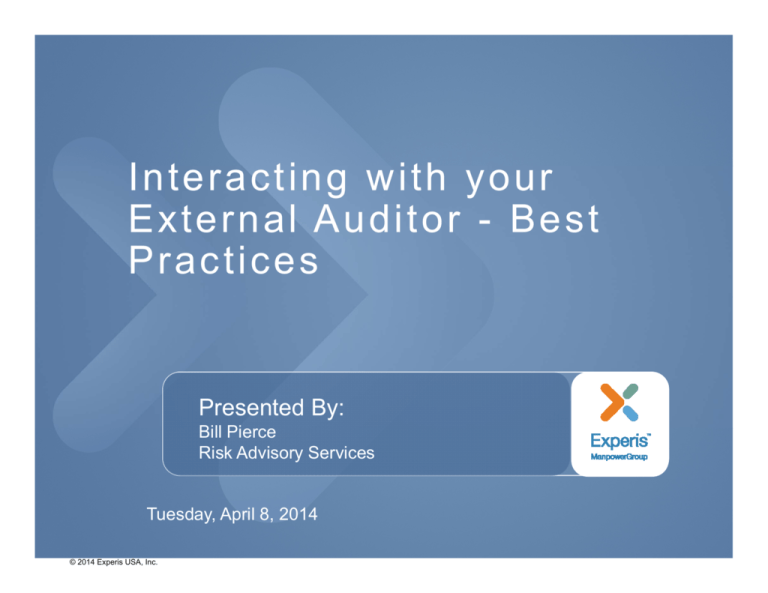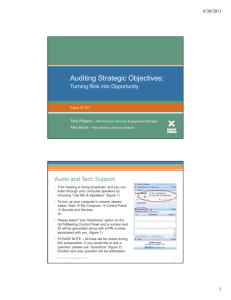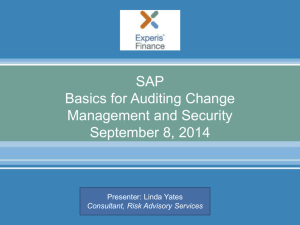Interacting with your External Auditor
advertisement

Interacting with your External Auditor - Best Practices Presented By: Bill Pierce Risk Advisory Services Tuesday, April 8, 2014 © 2014 Experis USA, Inc. Our Time Today • Effective Communication and Planning for Audits • What Drives Your External Auditors? • How to Leverage Internal Audit During External Audits • Reducing the Overall Burden of an External Audit • Closing Remarks Experis | Tuesday, April 8, 2014 © 2014 Experis USA, Inc. External Auditors You Effective Audits 2 Establish a Positive Tone for the Audit - Make the case (even if it’s not entirely true) that Finance, the external auditors, and the internal auditors are on the same team. You want to cooperate on the shared goal of getting the audit done effectively and efficiently. - Agree on working-level status meetings and tracking mechanisms to keep the audit on track and help avoid issues unnecessarily growing or going to the Audit Committee. Experis | Tuesday, April 8, 2014 © 2014 Experis USA, Inc. 3 Understand the Impact of Changes on the Audit - Changes in the Accounting Firm - New Partner or Concurring Partner - New Audit Manager or Staff - Changes in your company’s leadership - Changes in accounting policies or procedures - New business activities and/or significant transactions - New regulations and changes to existing regulations (SEC, PCAOB, FASB, IASB, IAASB) - Have any regulators cited your auditor? Focal points? Impact on your audit? Experis | Tuesday, April 8, 2014 © 2014 Experis USA, Inc. 4 Effective Communications – Start Early - Get concurrence, early, on any change in accounting principles or methods for significant accounting estimates. - Be clear and concise when documenting accounting positions, including supporting the basis for management’s decisions. - Ensure awareness of those who may be asked “why?”. - Coach staff on avoiding complications caused by hypothesizing on areas outside of their responsibility. Experis | Tuesday, April 8, 2014 © 2014 Experis USA, Inc. 5 Effective Audit Preparation Agree on Liaison/Point Person and Responsibilities Discuss Quarterly and Annual Audit Planning - Push for quarterly/interim testing to the extent possible - Consider shared Audit/SOX(or MAR) tracking documents - Establish consistent formats for PBC schedules - Leverage Finance team to complete audit documentation Coordinate with Information Technology - Ensure consideration of the impact on audit schedules and effort when timing system implementations and upgrades - Maintain period-end data files for significant balances and periodic activity transaction files for significant accounts Over-communicate and plan with Operations for key audit activities (such as Inventory Observations) Experis | Tuesday, April 8, 2014 © 2014 Experis USA, Inc. 6 PCAOB is Driving Auditors of Public Companies Auditors of public companies are subject to PCAOB Oversight - The largest firms are audited by the PCAOB annually – Results of PCAOB examinations in past 2-3 years have been very negative for the Big 4 relative to their prior results and the firms are under great pressure to improve going forward. PCAOB Staff Practice Alert No. 11, October 24, 2013 - Risk Assessment and the Audit of Internal Control - Selecting Controls to Test - Testing Management Review Controls - IT Considerations, including System-Generated Data and Reports - Roll-forward of Controls Tested at an Interim Date - Using the Work of Others - Evaluating Identified Control Deficiencies Experis | Tuesday, April 8, 2014 © 2014 Experis USA, Inc. 7 Reaction to Specific PCAOB Findings on SOX - Information Provided by Entity (IPE), a.k.a. Electronic Audit Evidence - A Population IPE is a report that identifies the population subject to a control from which samples are selected (Auditors must assure). - An Execution IPE is a report that is relied upon by the client when performing a control (Control Owners must assure). - Reliance should only be placed on reports if there is sufficient evidence to prove that the information provided is accurate and complete (Production report under tested Change Management may not be good enough). - Spreadsheets pose a special challenge. Experis | Tuesday, April 8, 2014 © 2014 Experis USA, Inc. 8 Reaction to Specific PCAOB Findings on SOX (cont) - Control Documentation and Definition - When PCAOB examiners have questions about controls, they ask the auditor to take them through Company’s control process documentation (narratives, flowcharts). - Must ensure your processes are well documented or PCAOB may challenge auditor’s opinion and management’s evaluation. - Controls must be more fully defined. Control descriptions cannot be just “The reconciliation is reviewed”. Attributes must be defined for: - How the reviewer performs the review. - What the reviewer does to determine completeness/accuracy. - Precision of the review (i.e., over $x must be investigated). - “How do they know?” - May need to enhance control activities. Experis | Tuesday, April 8, 2014 © 2014 Experis USA, Inc. 9 Reaction to Specific PCAOB Findings on SOX (cont) - Control Testing - Control testing should include more than one method (Inquiry, Observation, Inspection, Re-performance). - Don’t forget IPE (validate your population/sample and test reviewer’s validation as attribute of control execution). - Finding errors with review controls is good. - Control Owners will need to maintain additional documentation. - Ensure coverage of Q4. If management’s testing only included samples through Q3, year-end update should be more than just Inquiries about changes in Q4. - Adjust SOX plan for tests later in year or more work during year-end. Experis | Tuesday, April 8, 2014 © 2014 Experis USA, Inc. 10 Reaction to Specific PCAOB Findings on SOX (cont) - Relying on the Work of Others - The external auditor must determine whether the work is adequate for purposes of the audit based on: - Objectivity - Competence - Approach - PCAOB findings will result in more extensive review of IA work to be relied on. - Evaluating Control Deficiencies - Do audit adjustments indicate control deficiencies? - What are the risk factors affecting the likelihood of misstatement? - What are the risk factors affecting the magnitude of potential misstatement? - Are compensating control precise enough to prevent or detect? Experis | Tuesday, April 8, 2014 © 2014 Experis USA, Inc. 11 Steps to Leverage Internal Audit - The Chief Audit Executive should work with the CFO/CAO, Controller, and CIO before, during, and after the external audit to level set as a team. - Review results of ERM, IT, Fraud, and IA risk assessments with the external auditors. - Review control testing exceptions with the external auditors prior to any Audit Committee meetings. - The CAE can be in the best position to influence the external auditors to place greater reliance on internal control. The controls will have to be tested, but reduction of substantive testing should reduce audit fees. - Push external auditors for maximum reliance on the work of others. Do this early to maximize savings in audit fees. Experis | Tuesday, April 8, 2014 © 2014 Experis USA, Inc. 12 Ability to Leverage Internal Audit Depends on: Independence and Objectivity of Internal Audit - Functional reporting lines - CAE selection, evaluation and remuneration - Incentive structure Competency - Certifications - Training & development - Prior work experience Approach - Policies, procedures and adopted standards - Quality assurance of the function - Quality improvement program Experis | Tuesday, April 8, 2014 © 2014 Experis USA, Inc. 13 Critical Coordination and Awareness Items For any work on which the External Auditors will rely, must ensure coordination on: - Timing of work - Nature of work performed - Extent of audit coverage - Materiality thresholds - Selection methodology - Sample sizes - Documentation standards/templates - Review and reporting procedures Experis | Tuesday, April 8, 2014 © 2014 Experis USA, Inc. 14 Standards to Better Leverage Internal Audit - The IAASB issued ISA 610 (Revised), Using the Work of Internal Auditors in March of 2012. - It takes effect for all audits of financial reporting periods ending on or after December 15, 2013. What does it mean? - Establishes criteria for relying on the work of Internal Audit. - Requires external auditors (if they conclude to rely) to communicate how they plan to use the work of IA and coordinate the timing and nature of their work, the extent of audit coverage, etc… Experis | Tuesday, April 8, 2014 © 2014 Experis USA, Inc. 15 Reducing the Overall Burden of an External Audit Time of personnel, including those charged with governance - Ensure IA is leveraged. - Push the external auditor to manage permanent file and working files to reduce redundant documentation requests. Resources of internal audit and/or service providers serving in this capacity - Ensure Process Owners feel ownership of key controls – effective controls are easier to test. - Consider reducing documentation standards if no reliance (maybe not). Audit Fees - Contain with more effective and efficient audits. - Reduce with reliance on work of others. Experis | Tuesday, April 8, 2014 © 2014 Experis USA, Inc. 16 Questions? William R. Pierce CPA, CISA, CRISC Senior Manager Risk Advisory Services 919-755-5871 william.pierce@experis.com Experis | Tuesday, April 8, 2014 © 2014 Experis USA, Inc. 17







